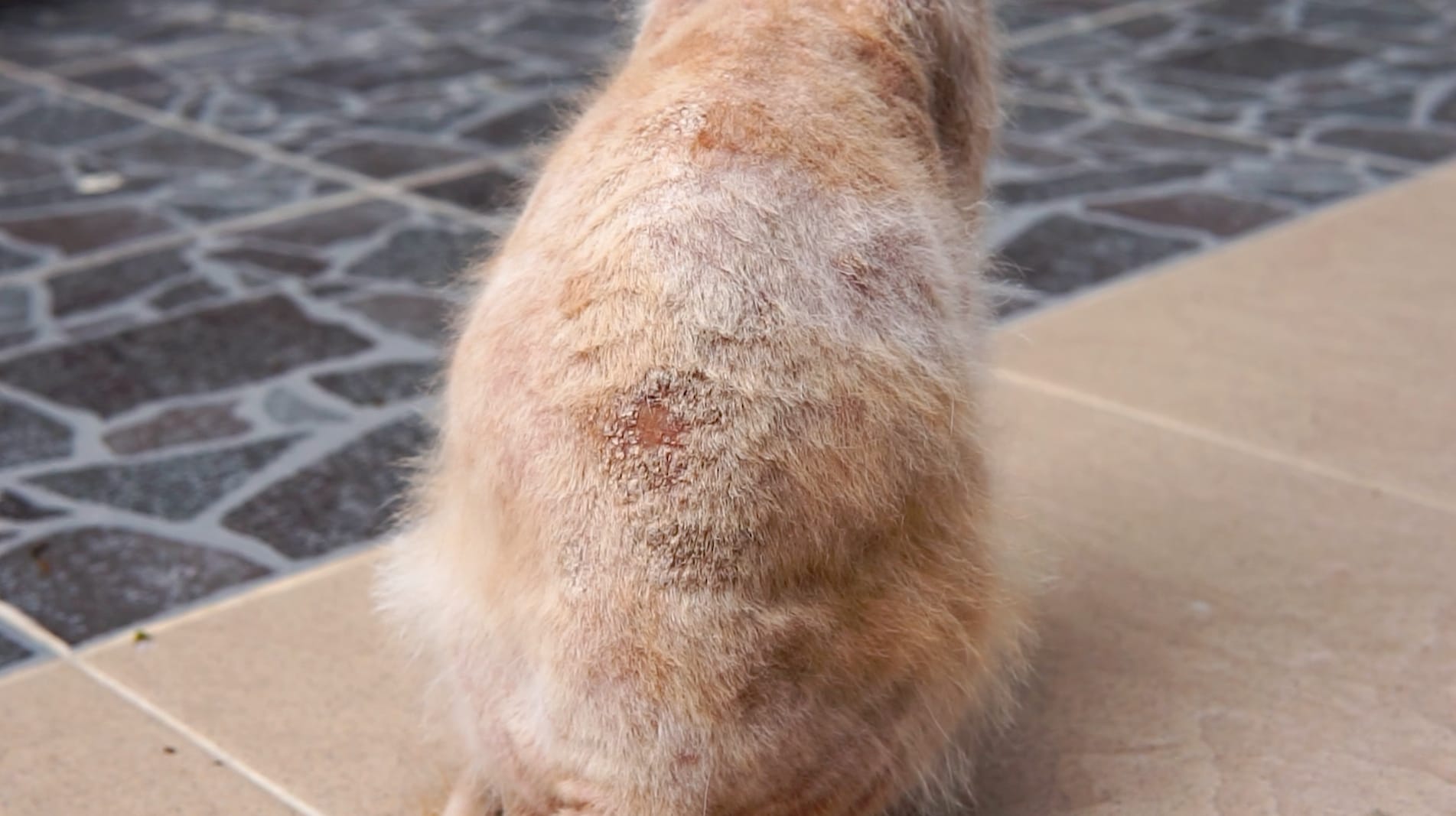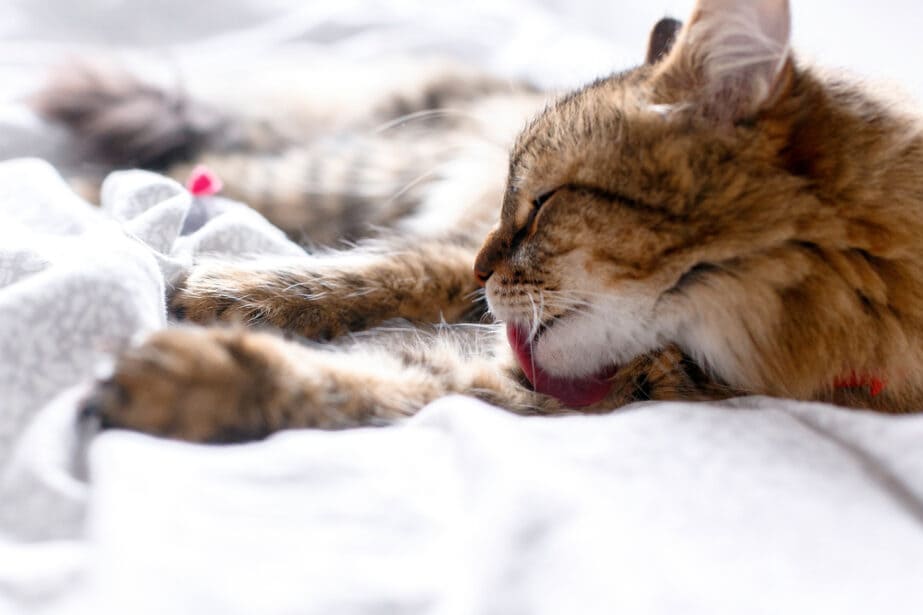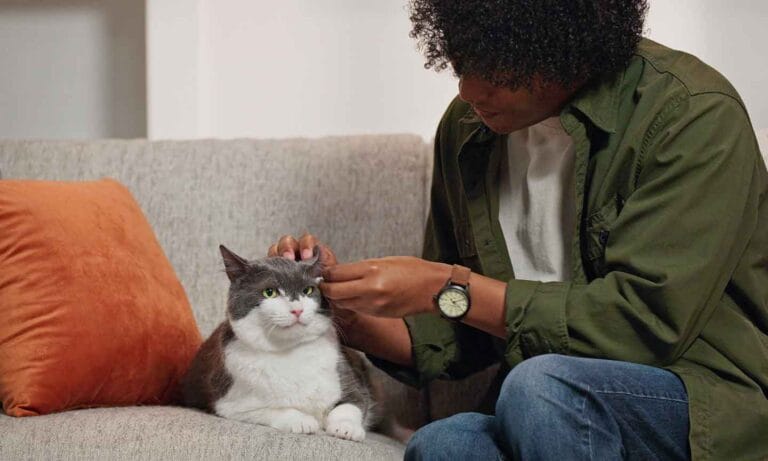Ringworm in cats is a common fungal infection that affects the skin, hair, and nails. Despite its creepy-crawly name, it’s not caused by worms (phew!) but by contagious fungi called dermatophytes. Because ringworm can spread quickly to other cats, other animals, and even humans, early identification and treatment is especially important.
We spoke to two veterinarians to learn the facts about ringworm in cats, including what it looks like, how it spreads, and how vets treat it.
In This Guide:
What Is Ringworm in Cats? And How Do Cats Get Them?
Ringworm is caused by dermatophytes—microscopic fungi that feed on keratin, a protein found in hair, skin, and nails. The term “ringworm” refers to the circular, ring-like lesions the infection often creates.
The most common strain of ringworm affecting cats? Microsporum canis.
“Depending on the species, some ringworm is more species-specific and some are more likely to infect multiple species,” says Rachel Cocchiaro, DVM, a veterinarian and partner at Bahama Road Veterinary Hospital in Bahama, North Carolina.
Cats can contract ringworm in a few ways, including:
- Direct contact with an infected animal: Physical contact with another animal (often cats, dogs, or rodents) carrying the infection is the most common cause.
- Exposure to contaminated environments: Spores can live for months on surfaces like bedding, furniture, grooming tools, toys, or soil, making it easy for cats to pick up the infection.
- Weakened immune systems: Young kittens, elderly cats, or those with compromised immune systems are more susceptible to infection.
- Crowded or unsanitary conditions: Cats in shelters, catteries, or multi-pet households are at higher risk due to close proximity and shared spaces.
- Contact with infected humans: Although rare, humans with ringworm can pass the infection to their cats through touch.
What Are the Signs of Ringworm in Cats?
Ringworm in cats isn’t life-threatening, but it can cause significant discomfort and irritation.
Symptoms of ringworm in cats may include:
- Thickened or rough patches of skin
- Circular areas of hair loss (which may appear patchy)
- Broken or stubby hair in affected areas
- Scaly, crusty, or flaky skin
- Changes in the fur or skin color
- Inflamed or irritated patches of skin
- Excessive grooming or persistent scratching
- Red or gray scaly lesions, often found on the head, chest, front legs, or spine
- Dull or lackluster coat
- Visible dandruff
- Hardening or rough texture at the base of the nails
- Distorted nails or unusual nail growth
If left untreated, hair loss will continue, exposing bare skin. This can increase the risk of skin wounds and subsequent infections.
It’s important to know that many cats, particularly long-haired breeds, can have ringworm without having any apparent symptoms. These cats, known as asymptomatic carriers, may still spread the infection to other pets or humans.
Pictures of Ringworm in Cats
A list of symptoms is useful, but pictures of ringworm in cats can provide an even clearer answer to the question, “What does ringworm look like in cats?”
Here is a visual example:

Photo: Aiman Khair bin Samsol Hairi/Creatas Video+/Getty Images Plus
How Do Vets Treat Ringworm in Cats?
In most cats, ringworm will resolve on its own within nine months to a year.
However, treatment is strongly recommended to eliminate discomfort and prevent the infection from spreading to other animals and humans.
Treatment can last anywhere from “six weeks up to two or three months, depending on the severity of infection and response to treatment,” says Bethany Hsia, DVM, co-founder of CodaPet, a nationwide end-of-life pet care service.
A cat is considered cured once they have two negative ringworm cultures one week apart.
To eliminate a ringworm infection, Dr. Hsia says veterinarians usually prescribe a combination of treatments.
Topical Treatment
Topical treatment involves applying an antifungal cream, ointment, or prescription spray containing miconazole directly to the affected areas.
Medicated Shampoo or Lime Sulfur Dip
For best results, Dr. Cocchiaro recommends using topical creams in combination with a bath using antifungal shampoo, such as Vetnique Labs Dermabliss Chlorhexidine Shampoo or Douxo S3 PYO Chlorhexidine Shampoo.
Lime sulfur dip is another standard option for treating ringworm.
With this option, sulfur lime concentrate, such as Vet Basics Lime Sulfur Dip, is diluted with water according to the directions, and then applied to the cat’s coat and skin. The dip is left to air dry on the cat without rinsing off. Baths or dips are typically administered twice a week.
Some cats may require sedation to allow for adequate contact time with the shampoo or dip.
“If a cat is too sick to tolerate a bath, oral treatment may need to be started until topical treatment is safe,” says Dr. Cocchiaro.
Discuss the best approach with your veterinarian.
Oral Medications
Oral antifungal medications—typically itraconazole, terbinafine, or griseofulvin—are often used in combination with topical treatments.
They are especially beneficial for cats who cannot tolerate baths or dips, have more severe infections, or have nail involvement.
Environmental Decontamination
Ringworm spores, which can cling to hairs shed by your cat, can survive in the environment for months.
While not every animal or person exposed will develop an infection, thoroughly cleaning your home can help prevent the spread and reduce the risk of reinfection in your cat.
Here are some cleaning tips:
- Avoid sweeping, as that will kick the spores up into the air. Instead, vacuum or mop all hard surfaces.
- Clean the surfaces with an antifungal disinfectant, such as Top Performance 256 Multi-Purpose Solution, leaving the solution on for at least 10 minutes.
- Clean and disinfect all bedding, carriers, and other materials your cat spends time on.
What Are Some Home Remedies for Ringworm in Cats?
While ringworm in cats requires veterinary diagnosis and treatment for complete recovery, some home remedies may help manage symptoms and prevent the infection from worsening.
While Dr. Cocchiaro says the best thing you can do at home is stay on top of disinfecting surfaces, she notes that over-the-counter antifungal sprays and wipes, such as Vetnique Labs Dermabliss Chlorhexidine Spray and Pet MD Chlorhexidine Wipes, can also be helpful. These products can be applied directly to your cat, especially between bath or dip treatments, to help manage the infection.
How Do I Prevent My Cat From Getting Ringworm?
Preventing ringworm in cats involves a holistic approach. Here are some ways to reduce your kitty’s risk.
Keep Your Cat Indoors
Cats kept indoors have a lower risk of exposure to infected animals, contaminated soil, or surfaces where ringworm spores can linger.
If you’d like your cat to enjoy the outdoors safely, consider providing a catio—an enclosed outdoor space—so they can get fresh air without the risk of infection.
Maintain Good Hygiene
Regularly clean your cat’s bedding, toys, and grooming tools to eliminate any potential fungal spores lingering on them.
Practice Regular Grooming
Frequent brushing not only keeps your cat’s coat healthy but also allows you to check for early signs of skin issues, including ringworm.
Quarantine New Pets
New kittens rescued from shelters or from a difficult outdoor living situation (for example, where there are a lot of other cats) are more predisposed to ringworm, says Dr. Cocchiaro
She recommends isolating a newly adopted kitten in a bathroom or small room for one to two weeks to monitor for signs of ringworm (and other contagious illnesses). Then, properly introduce the cats.
Other new pets—such as older cats, dogs, rabbits, and rodents—can also carry ringworm, so it’s important to take similar precautions when bringing them into your home. Animals purchased from reputable breeders are typically screened for ringworm beforehand, making them less of a concern in this regard.
Clean and Disinfect
Regularly clean floors, furniture, and other surfaces with a disinfectant effective against fungi—especially if you’ve had a previous case of ringworm in your home.
Strengthen Their Immune System
Support your cat’s immune system by feeding them a nutritious diet, keeping their stress low, and ensuring they’re up to date on routine veterinary care to support their immune system.
With your vet’s approval, you might also consider giving your cat an immune-boosting supplement, such as Nutramax Imuquin Immune Support or Vetoquinol Viralys Immune Supplement.
A strong immune system is a cat’s best defense against ringworm and other infections!
FAQs About Ringworm in Cats
Q:Can ringworm trigger hyperesthesia in cats?
A:Yes, ringworm can trigger hyperesthesia in cats (aka “twitchy cat syndrome”). The itching, irritation, and discomfort caused by the fungal infection may lead to the characteristic heightened skin sensitivity.
Q:Do steroids stop the ringworm in cats?
A:Steroids are not used to treat ringworm in cats because they suppress the immune system, making it harder for the body to fight off the fungal infection. Treatment typically involves antifungal medications prescribed by a veterinarian.
Q:Is it hard to get rid of ringworm in cats?
A:Ringworm can be challenging to treat because it’s highly contagious and the fungal spores can survive in the environment for months. However, with consistent treatment, including antifungal medications, topical treatments, and environmental cleaning, most cases can be resolved within weeks or months.
Q:How long is ringworm contagious in cats?
A:Ringworm in cats is contagious as long as fungal spores are present and active. With treatment, the infection is usually resolved within six weeks, though severe cases may take longer. Two consecutive negative fungal cultures, taken a week apart, confirm that the infection is no longer contagious.
This content was medically reviewed by Teresa Manucy, DVM, Chewy veterinarian.
Share:




















